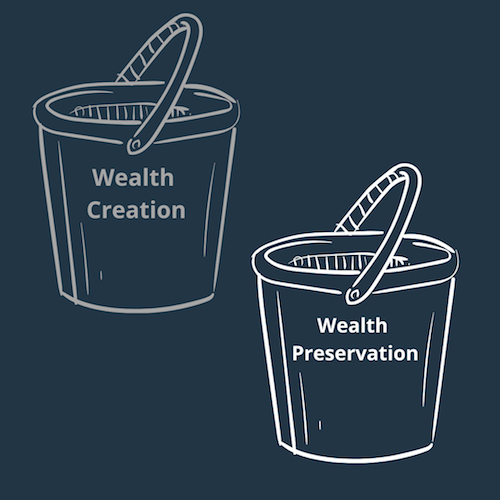Details Are Part of Our Difference
Embracing the Evidence at Anheuser-Busch – Mid 1980s
529 Best Practices
David Booth on How to Choose an Advisor
The One Minute Audio Clip You Need to Hear
Tag: Preserving Wealth
Make It and Preserve It

In one of his latest pieces for Forbes, Take the Long View podcast guest, John Jennings wrote about how the actions and values that lead to creating wealth are not the same as those used to preserve it. For example, risky and concentrated bets may have worked well in creating wealth but can be disastrous for preservation.
Preserving Wealth Is A Very Different Discipline Than Creating It
By John Jennings
Forbes.com – June 30, 2021
When I first started in wealth management, I thought that entrepreneurs, being risk-takers, would want high-octane, risky investment portfolios. I came to realize the opposite is true – a top priority for them is to preserve the wealth they have created. While building their business, they knew they could lose everything. As they take money out, they want to be sure to keep it.
Reid Hoffman is a partner in the venture capital firm Greylock Partners and a founder of PayPal and LinkedIn. At a conference I attended years ago, he was asked whether his PayPal experience led Greylock to invest in payment companies. He replied that Greylock hadn’t made any investments in payment firms since he became a partner because he had vetoed them. Hoffman knew how hard it was to create PayPal and how lucky they had been, so he was hyper-aware of the barriers that payments companies face. Hoffman knows that everything it takes to make your first $100 million can work against you when you’re trying to keep it.
Generating Great Wealth
While there are exceptions, if you want to generate significant wealth, you must own part of a successful business. High-income earners – like doctors and lawyers – make a nice living, but people who vault into tens of millions or more are business owners with remarkably similar strategies. They:
- Concentrate their assets, usually in a single company. This increases the chances of winning big if their one big bet pays off.
- Tolerate a high level of risk: their success or failure depends on their company. If it takes off, they are rich; if it flounders or fails, they aren’t.
- Are obsessed: they invest almost all their time and talent in their business. Building the company is their singular focus and takes over much of their lives.
And luck plays a role too. Looking back, successful company owners can identify how everything seemed to come together “just so.” If a few things had happened a bit differently, their company wouldn’t have been as successful. On the flip side, bad luck kills off many otherwise promising businesses.
Preserving Great Wealth
The strategies for preserving wealth are the opposite of those for generating it.
- Instead of being concentrated, diversify. Spreading wealth among many investments eliminates the chances of losing it all.
- Lower the overall level of risk by reducing leverage and building a margin of safety by allocating to bonds and cash
- Involvement moves from active to passive. Being an investor means investing in someone else’s company. Investors generally don’t influence the success of the companies in which they invest, so let the money do the work.
- Mitigate the effects of luck by following a disciplined investment process. Setting portfolio strategy and rebalancing are essential tools for long-term success.
Preserving wealth requires a mindset and discipline that avoid huge losses. I recently discussed with a client whether to put half of her wealth into a new business venture. If the business failed and she lost that money, it would affect her lifestyle and financial security. On the other hand, if the startup business took off and doubled or tripled her wealth, very little would change – she already had enough to achieve all her lifestyle and financial goals. Accordingly, she invested 20% of her money into the new business and found other investors to make up the difference.
Note that preserving wealth doesn’t preclude excellent returns; over the past decade, a 70/30 portfolio of globally diversified stocks and bonds more than doubled in value. Compounding returns in a diversified portfolio can turn great wealth into even greater wealth. But if you start with a modest investment, a doubling of value in a decade is a long way short of the outsized returns needed to turn it into tens or hundreds of millions of dollars.
Think of Two Buckets
After a successful business is sold, it’s important to keep the generating versus preserving wealth paradigm in mind when deciding how much to invest in another new business. Prior success doesn’t guarantee you’ll catch lightning in a bottle a second time.
I advise my clients to imagine two buckets and decide how much of their wealth should be in each. Taking this bucket view helps in several ways.
First, thinking in terms of two buckets help set expectations. The money in the generating wealth bucket can generate great returns or go to zero; 20% of new businesses fail within their first year, half survive five years, and only one-third make it to age ten. Money in the preservation bucket grows wealth less spectacularly, but reliably over the long term.
Second, as the value of a business grows, it may make sense to move value from the creating bucket to the preserving one. As William H. Vanderbilt once said, “Any fool can make a fortune. It takes a man of brains to hold onto it.” Or a person with two buckets.

